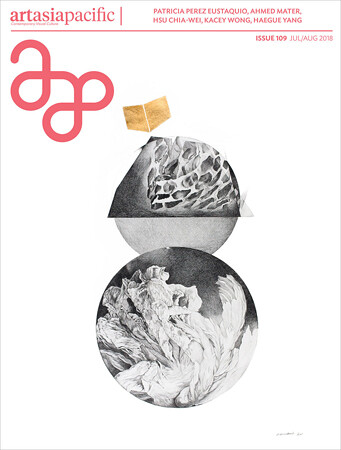July/August 2018
A saffron-painted merry cow and the mass-market dairy products it produces form the centerpiece of Yellow Cow (2006–10), a multi-part installation by the Saudi Arabian artist Ahmed Mater that catapults the Quran tale it references into the present day. That Mater the provocateur—who also ran the underground Pharan Studio in Jeddah—was recently appointed executive director of Crown Prince Mohammed bin Salman bin Abdulaziz al-Saud’s Misk Art Institute has caught the attention of many people in the Gulf and beyond.
This turn of events has ArtAsiaPacific’s Dubai desk editor Kevin Jones asking in his Feature: “Will the soft-power posturing and cultural-diplomacy of his job curtail or delimit his own artistic practice?” As Mater’s story, and those of other artists in the July/August issue of AAP demonstrate, something can be learned from fluid adaptation and internal resistance, as opposed to outright rejection of institutionalized systems and singular narratives.
Similarly entrenched in her own artistic community yet coolly distant from larger art-world narratives is our cover artist, Manila-based Patricia Perez Eustaquio, whose diverse practice—from amorphous-shaped canvases depicting lush yet rotting flowers to elaborate prints that employ room-size digital looms—has allowed her to embrace her label as a “feminine artist,” as well as operate outside of restrictive gender structures. From her early days dressing Manila’s luminaries in haute couture to recent minimalist presentations at the Singapore Biennale and Palais de Tokyo, Eustaquio has pushed her evolving relationship with materials and her own visual language—taught to her by the father of conceptual art in the Philippines, Roberto Chabet—toward ambiguity. As Josephine V. Roque writes in her Feature, “The blurred effect [of her works] upends faulty preconceptions through the manipulation of contrasts: decorative craft versus fine art; still life versus abstraction; growth versus decay; macro and micro; and masculine versus feminine.”
Also in the Features section, in Young and Emerging, we look at the practices of five artists—Mari Katayama, Justin Shoulder, Mary Maggic, Behnaz Farahi and Gary Zhexi Zhang—who envision new bodies and biologies at the intersection of science, myth and identity. Then and Now digs up articles from our Digital Library, including Nalini Malani’s innovative projects from the 1990s and the aftermath of the violent 2010 Bangkok riots from which Ravinder Reddy’s four-meter-high gilded head emerged mysteriously unharmed. Inside Burger Collection examines the work of Sylvie Fleury, whose text-based aphorisms say more about our consumerist world than at first glance, as elaborated by Johannes Hoerning.
Elsewhere in the magazine, artists and individuals make conscious choices to think outside—as well as within—the box. In Profiles, Melbourne-based collector and property developer Michael Buxton, who inaugurated the Buxton Contemporary museum earlier this year, reveals the fastidious process of acquiring works by contemporary Australasian artists, with input from art consultants, an advisory board and, above all, Buxton’s clear-eyed vision for giving back to his home city. From her Brooklyn studio, artist, curator and activist Jaishri Abichandani challenges the hyper-conservative expectations of women by invoking progressive, contemporary figures and celebrates them by merging their likenesses with allegorical female representations from Indus Valley artifacts. Rounding out Profiles, Hsu Chia-Wei blurs history by forcing reflections on truth, fiction and myth, through his videos that utilize diverse filmmaking techniques as a means to probe Taiwan’s history.
In Dispatch, independent researcher Fiona Cheng writes of the anti-institutional activism practiced by the artists in Taiwan’s second-tier city, Taichung, which is fighting to shed its crime-riddled image. As the city’s artists choose to self-fund their practices, spaces and activities—rather than rely on the abundant government support available to them—their perspective on art-making is more “middle-of-the-road” (or realistic) than that of their peers in other metropolises. In The Point, artist Yan Xing laments the overripe topic of “identity” and criticizes the ways in which museums, galleries, magazines and even artists themselves describe artworks from China or those derived from Chinese culture. Multimedia artist and activist Kacey Wong, for One on One, remembers a departed friend who taught him about the emotional nuances of patriotism, which Wong experienced during the pro-democracy protests in Hong Kong in 2014. In Reviews, we catch Haegue Yang’s major European midcareer retrospective at Museum Ludwig in Cologne, as well as other shows around the world. For Where I Work, editor-at-large HG Masters visited the studio of Emre Hüner, whose multimedia practice of drawing, video and sculpture blurs the lines between science fiction and archaeology.
In Essays, contributor Ben Valentine notes that aspects of Khmer classical dance, robam kbach boran, can be detrimental to the progressive rights of women as well as other marginalized individuals. Framing the practice of Cambodian-American choreographer and queer dancer Prumsodun Ok around the mythical Khmer tale of Moni Mekhala, goddess of the seas whose empathetic nature blesses the country with quenching rain and ample harvests, Valentine discusses the reclamation of the derogative stereotypes that plague Ok and others’ upbringings. Together, the articles in AAP 109 suggest that to set ourselves free, perhaps it’s not necessary to start anew, but simply to rework the structures of the past.
Subscribe to the print edition or buy digital copies on iTunes, Google Play, Zinio or Magzter. Subscribers can access our entire back-issue catalog in ArtAsiaPacific’s Digital Library. Download the ArtAsiaPacific City Guide app today to be in the know about events and openings in 53 countries and territories across Asia, the Pacific and the Middle East!


